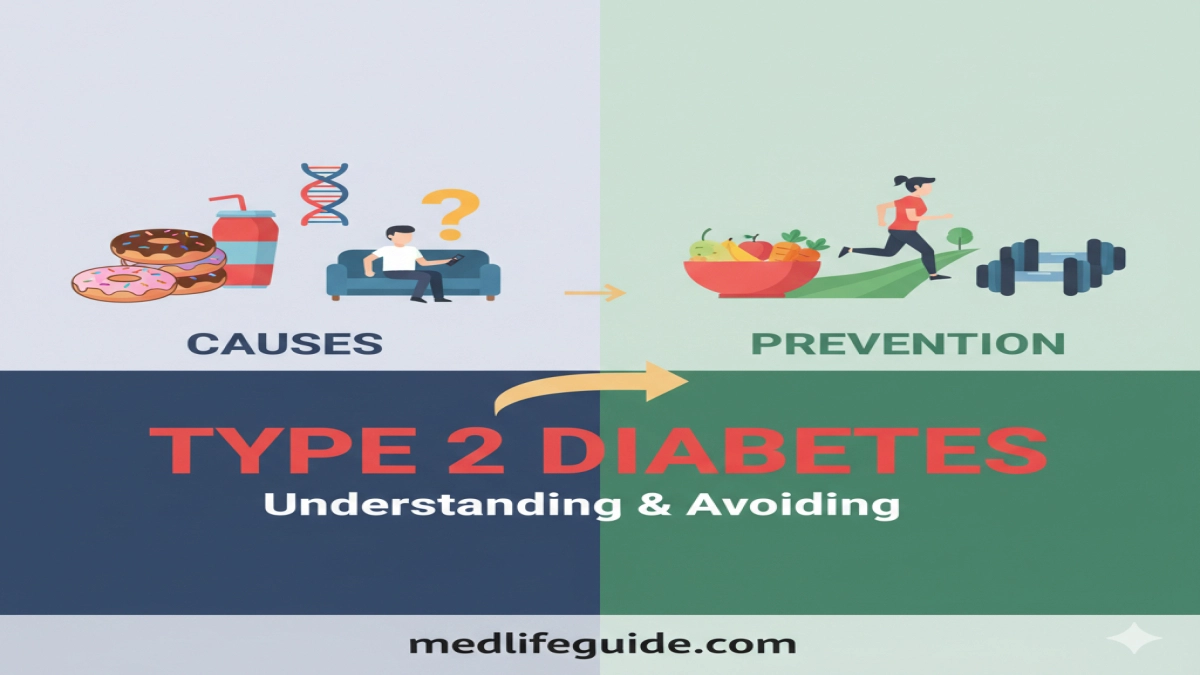Medically Reviewed and Compiled by Dr. [Adam N. Khan], MD.
Quick summary
Type 2 diabetes happens when the body cannot use insulin properly and the pancreas can no longer keep up. Major drivers are excess body fat, physical inactivity, unhealthy diet, age, and genetics. Most cases can be delayed or prevented with sustained lifestyle change, targeted screening, and — when appropriate — medications or surgery. The rest of this article explains how and why, and gives practical, clinic-ready prevention steps and three advanced clinical takeaways.
What is type 2 diabetes?
Type 2 diabetes is a chronic metabolic disease defined by high blood glucose due to insulin resistance plus progressive failure of pancreatic beta cells. It is the most common form of diabetes worldwide and leads to higher risk of heart disease, kidney failure, blindness, neuropathy, and premature death when not treated.
Causes — the biology, risk factors, and drivers
How it develops (simple chain)
- Insulin resistance — body tissues (muscle, fat, liver) respond less to insulin.
- Beta cell compensation and failure — early on the pancreas makes more insulin. Over time, beta cells fail and insulin production falls.
- Persistent hyperglycemia — blood sugar stays high, causing complications.
Major risk factors
- Overweight and obesity. Central (abdominal) fat strongly predicts risk. Excess adipose tissue produces inflammatory signals that worsen insulin resistance.
- Physical inactivity. Low physical activity lowers muscle glucose uptake and increases insulin resistance.
- Unhealthy diet. High calories, processed foods, saturated fats, and excess refined carbohydrates raise risk. Emerging large studies also link high processed-meat intake to higher diabetes risk.
- Age and ethnicity. Risk rises with age and is higher in many nonwhite populations due to a mix of genetic and socioeconomic factors.
- Family history and genetics. Inherited predisposition makes some people more likely to develop insulin resistance and beta cell dysfunction.
- Metabolic comorbidities. Nonalcoholic fatty liver disease, polycystic ovary syndrome, hypertension, and dyslipidemia increase risk.
Less obvious contributors
- Sleep problems and stress. Chronic poor sleep, sleep apnea, and high stress hormone exposure raise insulin resistance.
- Certain medications and medical conditions. Long-term steroids, some antipsychotics, and conditions like Cushing syndrome increase risk.
- Social determinants. Food access, built environment, and education shape the ease of prevention.
Prevention — evidence-based strategies that work
1. Proven lifestyle changes
Trials and public health guidance show the single most powerful prevention tools are weight loss, improved diet, and increased physical activity. Programs that combine modest weight loss (5–10% of body weight) with 150 minutes per week of moderate activity reduce progression from prediabetes to diabetes.
Practical steps:
- Aim for 150 minutes per week of moderate aerobic exercise plus two sessions of resistance training.
- Reduce calorie intake and focus on whole foods: vegetables, fruits, whole grains, legumes, nuts, and lean protein while limiting processed foods and sugary drinks.
- Target a 5 to 10 percent weight loss if overweight; this has the largest single impact on lowering risk.
2. Screening and early detection
Identify people with prediabetes or early diabetes through fasting glucose, HbA1c, or 2-hour glucose tolerance testing based on risk profile (age, BMI, family history, ethnicity). Early identification allows structured prevention programs.
3. Pharmacologic prevention (when lifestyle alone is not enough)
- Metformin has strong evidence to delay diabetes in high-risk individuals, especially younger, more obese people with higher fasting glucose.
- Newer medications (GLP-1 receptor agonists and SGLT2 inhibitors) influence weight and cardiometabolic risk; guidelines are evolving about their preventive role. ADA guidance updates discuss these classes in the context of obesity and diabetes care. Decisions must be individualized.
4. Bariatric/metabolic surgery
For severe obesity, bariatric surgery reduces incidence of type 2 diabetes and can induce remission in many patients. It is an option when clinical criteria are met and lifestyle/medical therapy have failed.
5. Population and policy measures
Improving access to healthy food, safe places to exercise, tobacco control, and health education measurably reduce diabetes burden across communities. WHO and Lancet analyses stress policy-level interventions.
Screening and monitoring — who, when, and how often
- Start screening adults at 35 to 40, earlier if overweight and with risk factors (some groups recommend starting at 30 or earlier for high-risk ethnicities). Repeat testing every 3 years if normal, more often if prediabetes or other risk factors. Use fasting glucose, HbA1c, or 2-hour OGTT as appropriate.
Management principles to reduce progression and complications
- Address weight and activity first. Lifestyle interventions form the backbone.
- Use medications as tools, not substitutes, especially when rapid risk reduction or weight loss is required. Metformin is well supported for prevention in selected patients. Newer agents can be highly effective for weight and cardiometabolic risk but require specialist input.
- Treat comorbid cardiovascular risk factors aggressively. Blood pressure, lipids, and smoking cessation yield major benefit.
Unique Clinical Takeaways
This section contains clinician-focused, actionable insights that go beyond the basic symptom or prevention list.
1. Match prevention strategy to the patient’s metabolic phenotype
Not all prediabetes looks the same. Some patients have predominant hepatic insulin resistance with high fasting glucose, while others have muscle insulin resistance and isolated postprandial hyperglycemia. Tailor interventions:
- Hepatic-predominant patients often respond well to calorie restriction and short-term low-carbohydrate approaches to rapidly lower fasting glucose.
- Patients with large postprandial excursions benefit from higher-protein meals, distributed carbohydrate intake, and resistance training to improve muscle glucose uptake.
This metabolic matching increases early success and adherence.
2. Use incremental, measurable goals to prevent “all-or-nothing” failure
Clinicians should set small, measurable targets—2 to 5 percent weight loss in 3 months, adding 10 minutes of daily walkers, or replacing one sugary drink per day—then build. Documenting small wins predicts long-term success more than prescribing a large, undefined goal. Programs tied to frequent follow-up (in-person or remote) show better outcomes.
3. Screen for and treat sleep apnea and depression early
Both obstructive sleep apnea and depression worsen insulin resistance and reduce capacity to adhere to lifestyle change. For patients with obesity, loud snoring, daytime sleepiness, or depressive symptoms, add screening tools and early referral for treatment; treating these comorbidities often amplifies the effect of lifestyle interventions. This reduces the chance that a reversible driver goes untreated.
4. Consider early combined therapy in very high-risk patients
For patients with multiple high-risk features (BMI over 35, strong family history, rapidly rising HbA1c within prediabetes range), consider early short-term pharmacologic therapy (for example, metformin or even specialist-supervised GLP-1 therapy aimed at weight loss) alongside lifestyle programs. This multi-pronged approach can prevent beta cell exhaustion and buy time for sustained behavior change. Discuss benefits, costs, and long-term plans with the patient.
5. Watch for and address social barriers up front
Ask about food affordability, transportation, work schedules, and caregiving responsibilities. Simple clinic-level changes—prescribing a local community program, connecting patients to dietitians who accept insurance, or arranging brief telehealth follow-ups—boost participation in prevention programs. Population-level policy is needed, but clinicians can reduce friction at the bedside.
Practical patient handout (what to do this month)
- Get baseline tests: fasting glucose or HbA1c, lipid panel, liver enzymes, blood pressure.
- Start 10–15 minutes of daily walking and add 5 minutes each week until you reach 30 minutes.
- Replace sugary drinks with water or unsweetened drinks.
- Aim for a 5 percent body weight reduction in three months; small weight loss already lowers risk.
- If you have prediabetes, ask about a structured lifestyle program such as the CDC Diabetes Prevention Program or local equivalent.
FAQs (short)
Q: Can type 2 diabetes be reversed?
In early stages and with substantial weight loss, remission is possible for many. Remission requires sustained weight control and close monitoring.
Q: Is medication required to prevent diabetes?
Not always. Lifestyle change is first line. Metformin is an evidence-based option for high-risk patients; newer drugs may be used selectively. Discuss risks, benefits, and cost with patients.
Q: Are there diets proven to prevent diabetes?
No single diet is best. Diets emphasizing whole foods, calorie control, reduced processed food and refined carbs, and appropriate portion sizes are effective. Individualize dietary counseling.
References and Citations
Listed below are the primary authoritative sources used for facts and recommendations in this article.
- American Diabetes Association — “Understanding Type 2 Diabetes.” American Diabetes Association
- Centers for Disease Control and Prevention — “About Type 2 Diabetes” and “On Your Way to Preventing Type 2 Diabetes.” CDC+1
- World Health Organization — “Diabetes fact sheet” and related prevention guidance. World Health Organization+1
- Lu X, et al. “Type 2 diabetes: pathogenesis, prevention, therapy” (Nature review). Nature
- New England Journal of Medicine — Glycemia reduction and clinical outcomes reviews. New England Journal of Medicine
- The Lancet / Lancet Diabetes & Endocrinology — epidemiology and policy perspectives. The Lancet+1
Medical disclaimer
This article is for general medical information only. It does not replace personalized medical advice. For diagnosis or treatment, consult your healthcare provider. If you have symptoms that worry you or urgent concerns, seek immediate medical attention.

